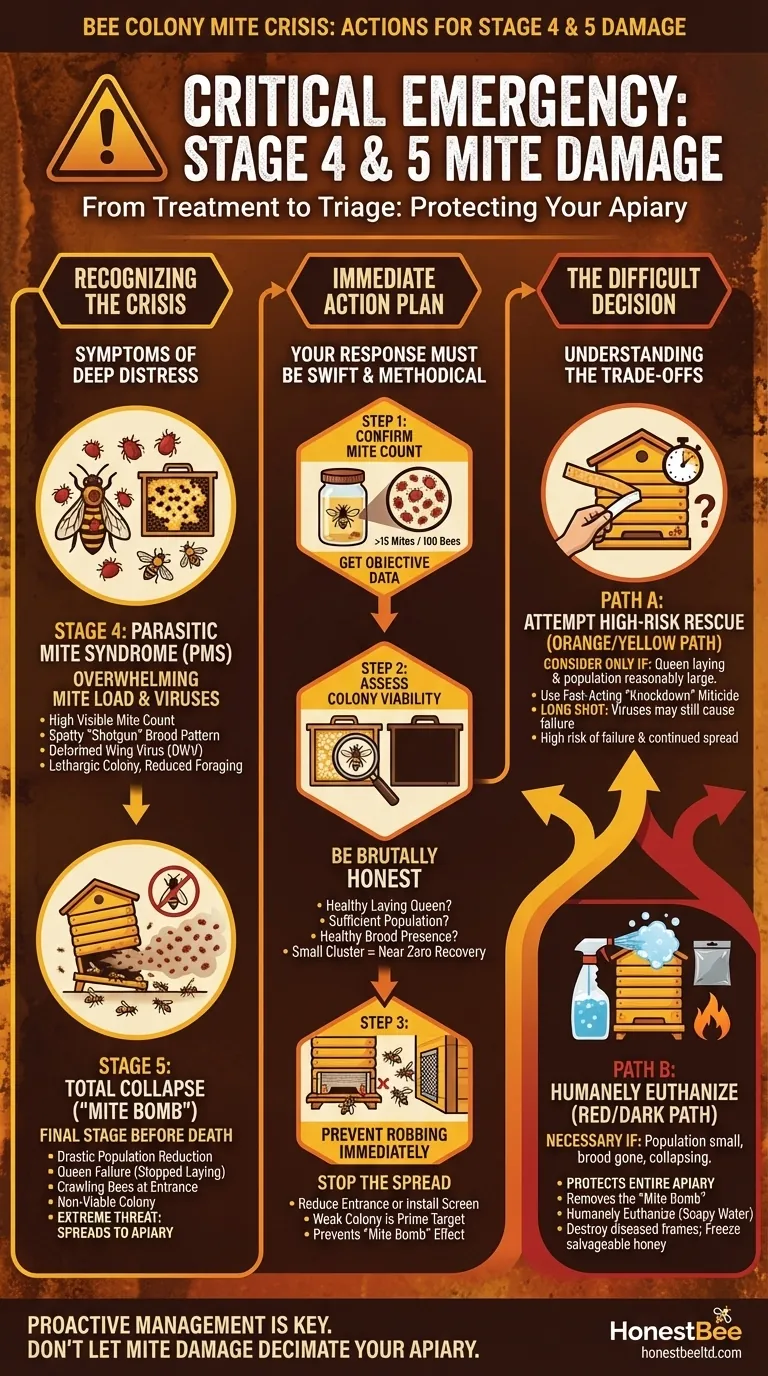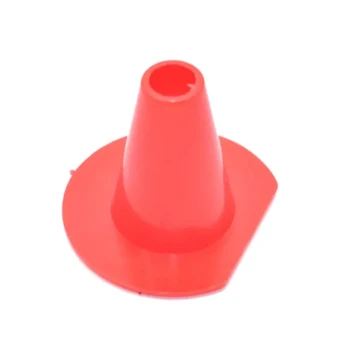When a bee colony reaches Stage 4 or 5 of mite damage, the situation is a critical emergency. The primary goal shifts from simple treatment to assessing viability and protecting your other colonies from a catastrophic spread of mites and viruses. While immediate action is required, you must be prepared for the strong possibility that it is too late to save the hive.
At Stages 4 and 5, you are no longer just fighting mites; you are managing a potential hive collapse. Your actions must be decisive, focusing on whether to attempt a rescue or to humanely euthanize the colony to protect your entire apiary.

Recognizing the Crisis: What Stages 4 & 5 Look Like
Before taking action, it's crucial to confirm you are dealing with a late-stage infestation. These symptoms are unambiguous and signal a colony in deep distress.
Symptoms of Stage 4 (Parasitic Mite Syndrome)
At this stage, the mite load is overwhelming the colony's defenses. You will likely see Parasitic Mite Syndrome (PMS), a collection of symptoms caused by both the mites and the viruses they transmit.
Key indicators include a high number of mites visible on adult bees, a spotty "shotgun" brood pattern, and the presence of bees with deformed wings (a sign of Deformed Wing Virus). The colony will appear lethargic, with reduced foraging activity.
Symptoms of Stage 5 (Total Collapse)
This is the final stage before the colony dies out completely. The bee population will be drastically reduced, and you may find the queen has stopped laying or is failing.
Many of the remaining bees will be crawling near the hive entrance, unable to fly. The colony is no longer viable and is often referred to as a "mite bomb," posing an extreme threat to any other hives in the area.
Your Immediate Action Plan
Your response must be swift and methodical. The goal is to gather information to make the best possible decision for your entire operation.
Step 1: Confirm the Mite Count
Even with clear visual signs, perform an immediate alcohol wash or sugar roll test. This provides objective data on the severity of the infestation.
At these stages, mite counts will be extremely high (e.g., over 15 mites per 100 bees), confirming the need for a drastic response.
Step 2: Assess Colony Viability
Be brutally honest in your assessment. Is there a healthy-looking queen still laying eggs? Is there a sufficient population of adult bees to maintain the cluster and care for any remaining brood?
If the cluster is smaller than a few frames or there is almost no healthy brood left, the chances of recovery are virtually zero.
Step 3: Prevent Robbing Immediately
Reduce the hive entrance to its smallest opening or install a robbing screen. A weak, collapsing colony is a prime target for robbing by stronger hives.
Robbing is the primary vector for spreading the massive mite and virus load to your healthy colonies, potentially triggering a cascading collapse throughout your apiary.
Understanding the Trade-offs: The Difficult Decision
At this point, you have two choices: attempt a high-risk rescue or euthanize the colony to protect the apiary. Sentiment cannot guide this decision.
When to Attempt Treatment
A rescue attempt is a long shot, but it might be considered if the queen is still laying and the population, while weakened, is still reasonably large.
You must use a fast-acting, "knockdown" miticide. However, understand that even if the treatment kills the mites, the surviving bees are likely saturated with viruses, which may prevent the colony's recovery.
When to Humanely Euthanize
Euthanizing the colony is often the most responsible decision for the health of your entire apiary. This action is necessary if the population is too small, the brood is gone, or the colony is clearly collapsing.
This removes the "mite bomb" from your apiary, preventing the infection of your other hives. The colony can be humanely euthanized by spraying the bees with soapy water.
Managing the Equipment
After the colony has died or been euthanized, you must manage the equipment carefully. Frames with dead or diseased brood should be destroyed. Honey frames may be salvageable for other strong colonies but should be frozen for at least 48 hours to kill any lingering mites or wax moth larvae.
Making the Right Choice for Your Goal
The best way to handle Stages 4 and 5 is to implement a management strategy that ensures you never reach them. However, when faced with this crisis, your priorities must be clear.
- If your primary focus is salvaging a specific colony: Act immediately with a fast-acting treatment, but be fully prepared for the colony to fail anyway due to the irreversible viral damage.
- If your primary focus is protecting your entire apiary: You must strongly consider euthanizing the Stage 4/5 colony to prevent it from becoming a mite bomb that infects your healthy hives.
- If your primary focus is future prevention: This event must serve as a catalyst to implement a strict, year-round Integrated Pest Management (IPM) plan based on regular monitoring and treating before mite populations can explode.
Proactive mite management is defined by consistent monitoring and early intervention, not by last-minute rescue missions.
Summary Table:
| Action Step | Key Objective | Critical Consideration |
|---|---|---|
| Confirm Mite Count | Get objective data on infestation severity. | Counts will be extremely high (>15 mites/100 bees). |
| Assess Colony Viability | Decide if rescue is possible. | Is there a healthy queen & sufficient bee population? |
| Prevent Robbing | Stop the spread to other hives. | A weak colony is a prime target; it's a 'mite bomb'. |
| Make the Decision: Treat or Euthanize | Choose the best path for your apiary's health. | Rescue is a long shot; euthanizing protects other colonies. |
Don't Let Mite Damage Decimate Your Apiary
Facing a hive emergency is a stark reminder of the importance of proactive management and having the right equipment. At HONESTBEE, we supply commercial apiaries and beekeeping equipment distributors with the wholesale-focused supplies needed for effective Integrated Pest Management (IPM).
Let us help you build a resilient operation. From mite treatments to essential hive tools, we provide the reliable equipment to protect your investment.
Protect your bees and your business. Contact our expert team today to discuss your wholesale needs.
Visual Guide

Related Products
- Economy Galvanized Beekeeping Honey Bee Smoker for Wholesale
- Metal Queen Bee Excluder for Beekeeping
- Professional Bee Smoker with Elongated Spout and Durable Bellows for Beekeeping
- Wooden Queen Bee Excluder for Beekeeping
- Professional Plastic Queen Excluder for Modern Beekeeping
People Also Ask
- What are the common design features of a bee smoker? Choose the Right Smoker for Your Apiary
- What is the purpose of a bee smoker and how should it be used? A Guide to Calm, Safe Hive Inspections
- What is a bee smoker and what is its primary purpose? Master Safe Hive Inspections
- How did early beekeepers use bee smokers? Master Ancient Bee Calming Techniques
- What is the purpose of a bee smoker in beekeeping? Ensure Calm, Safe Hive Inspections



















